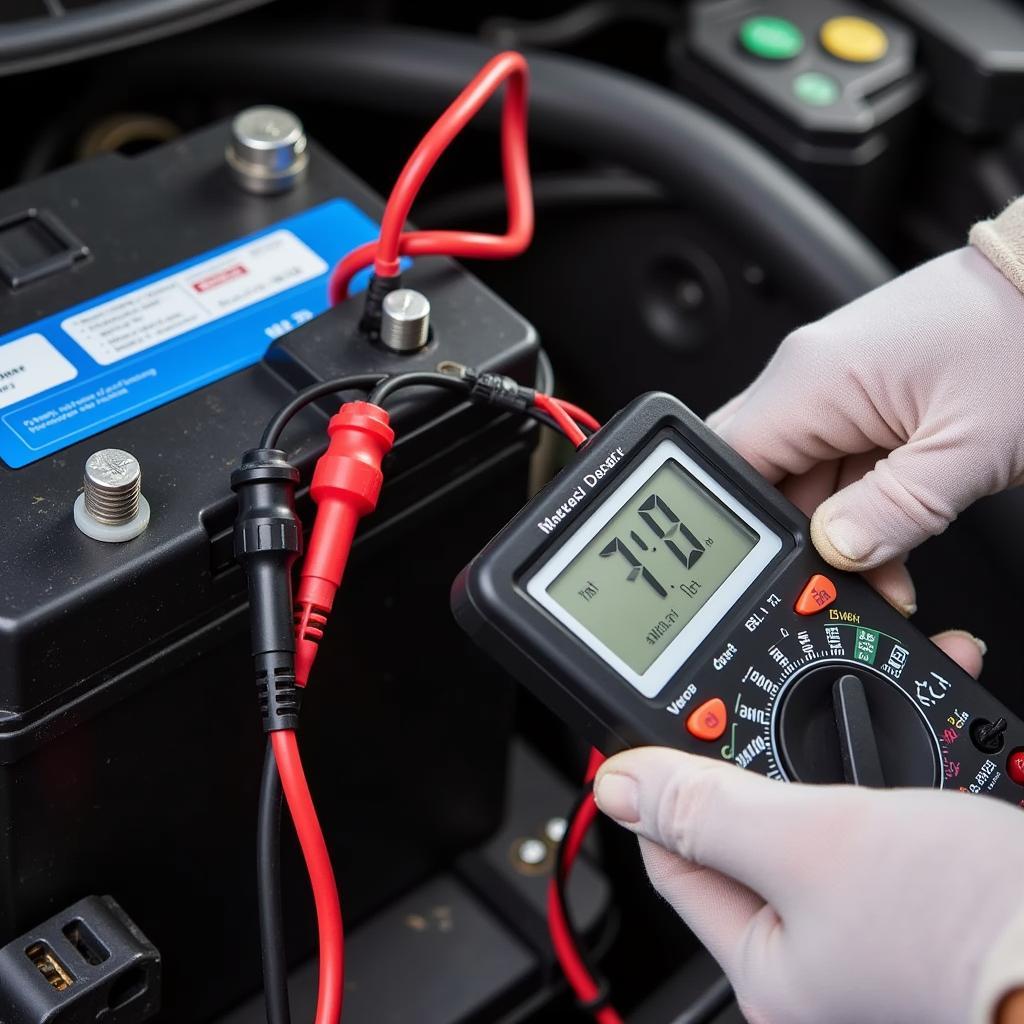A dead car battery is frustrating, especially when it’s due to a slow, insidious drain. This “cold drain car battery” issue can leave you stranded and searching for answers. This guide will equip you with the knowledge and tools to diagnose and even fix the problem yourself.
Understanding Cold Drain
A cold drain occurs when something in your car continues to draw power even after the ignition is off. This can be anything from a faulty interior light to a more complex electrical issue. Over time, this constant drain depletes the battery, leading to that dreaded “click” when you turn the key. Identifying the culprit requires a systematic approach.
How to Diagnose a Cold Drain
Diagnosing a cold drain isn’t as daunting as it sounds. With a few simple tools and a bit of patience, you can pinpoint the source of the drain. You’ll need a multimeter, ideally one with a min/max function, and a test light.
- Safety First: Disconnect the negative battery terminal to prevent any accidental shorts.
- Measure the Drain: Reconnect the negative terminal through your multimeter, set to measure DC amps. Observe the reading. A healthy car should have a drain of less than 50 milliamps (0.05 amps). Anything significantly higher indicates a problem.
- Isolate the Circuits: One by one, remove fuses from the fuse box while observing the multimeter reading. If the reading drops significantly when you remove a particular fuse, you’ve identified the circuit with the excessive drain. Consult your car’s owner’s manual to identify the components on that circuit.
- Narrow Down the Culprit: Within the identified circuit, check each component for faults. This might involve inspecting wiring, testing switches, or using the test light to check for power where it shouldn’t be.
 Checking the car fuse box to identify the circuit causing the battery drain
Checking the car fuse box to identify the circuit causing the battery drain
Common Causes of Cold Drain
Several common culprits can lead to a cold drain. Here are some of the most frequent offenders:
- Interior Lights: A stuck trunk light, glove box light, or even a faulty door switch can cause a constant drain.
- Faulty Radio or Amplifier: Aftermarket stereos or amplifiers can sometimes be wired incorrectly, leading to a parasitic drain.
- Bad Alternator Diode: A failing diode in the alternator can allow current to flow back into the battery, draining it even when the car is off.
- Faulty Ignition Switch: A worn ignition switch can sometimes fail to fully disengage, leaving certain circuits powered.
- Clock or Other Electronic Modules: Even seemingly small electronics can contribute to a drain if they malfunction.
“A seemingly small drain can have a big impact over time,” says John Miller, a senior automotive electrical engineer. “It’s crucial to address these issues promptly to avoid being stranded.”
Remote Diagnostics and Programming
In some cases, a cold drain can be caused by software glitches in the car’s electronic control units (ECUs). Remote diagnostic tools and software programming can sometimes resolve these issues without requiring physical access to the vehicle. This can be a convenient and efficient solution for certain software-related problems. If you suspect a software issue, consulting a specialist in remote diagnostics and programming might be beneficial. Sometimes, a simple software update can fix a persistent cold drain issue. Check out helpful resources for Seat Ibiza ABS and handbrake warnings, Seat Ibiza warning light symbols, 2010 Chrysler Sebring brake warning lights, flashing red brake warning lights, or Porsche Cayenne brake proportioning warnings if you encounter these specific problems.
Preventing Cold Drain
While diagnosing and fixing a cold drain is important, preventing it altogether is even better. Here are some preventative measures you can take:
- Regularly Inspect Your Car’s Electrical System: Look for frayed wires, loose connections, and any signs of corrosion.
- Be Mindful of Aftermarket Installations: Ensure any aftermarket electronics are properly installed and wired.
- Address Warning Lights Promptly: Don’t ignore warning lights related to your electrical system. They can be an early indicator of a potential problem.
“Preventative maintenance is key to a healthy car battery,” advises Maria Sanchez, an automotive technician with over 20 years of experience. “Regular checks can save you time, money, and frustration down the road.”
Conclusion
A cold drain car battery can be a nuisance, but with the right knowledge and tools, you can diagnose and fix the problem. By understanding the common causes and following the diagnostic steps outlined in this guide, you can keep your battery healthy and avoid unexpected breakdowns. Regularly inspecting your car’s electrical system and addressing any warning lights promptly can further prevent future cold drain issues.
FAQ
- What is a normal battery drain reading? Less than 50 milliamps (0.05 amps).
- Can a bad alternator cause a cold drain? Yes, a faulty alternator diode can drain the battery.
- How do I test for a cold drain? Use a multimeter to measure the current draw with the ignition off.
- What are some common causes of cold drain? Interior lights, faulty radio, bad alternator diode, faulty ignition switch.
- How can I prevent cold drain? Regular inspections, proper aftermarket installations, and addressing warning lights promptly.
- Can remote diagnostics help with cold drain? Yes, for software-related issues.
- What tools do I need to diagnose a cold drain? A multimeter and a test light.



